Prepare to sleep
Guiding users to better sleep with a personalized wind down routine to increase sleep quality and daily app engagement
Company
Sleep Reset
Role
Sole Product Designer
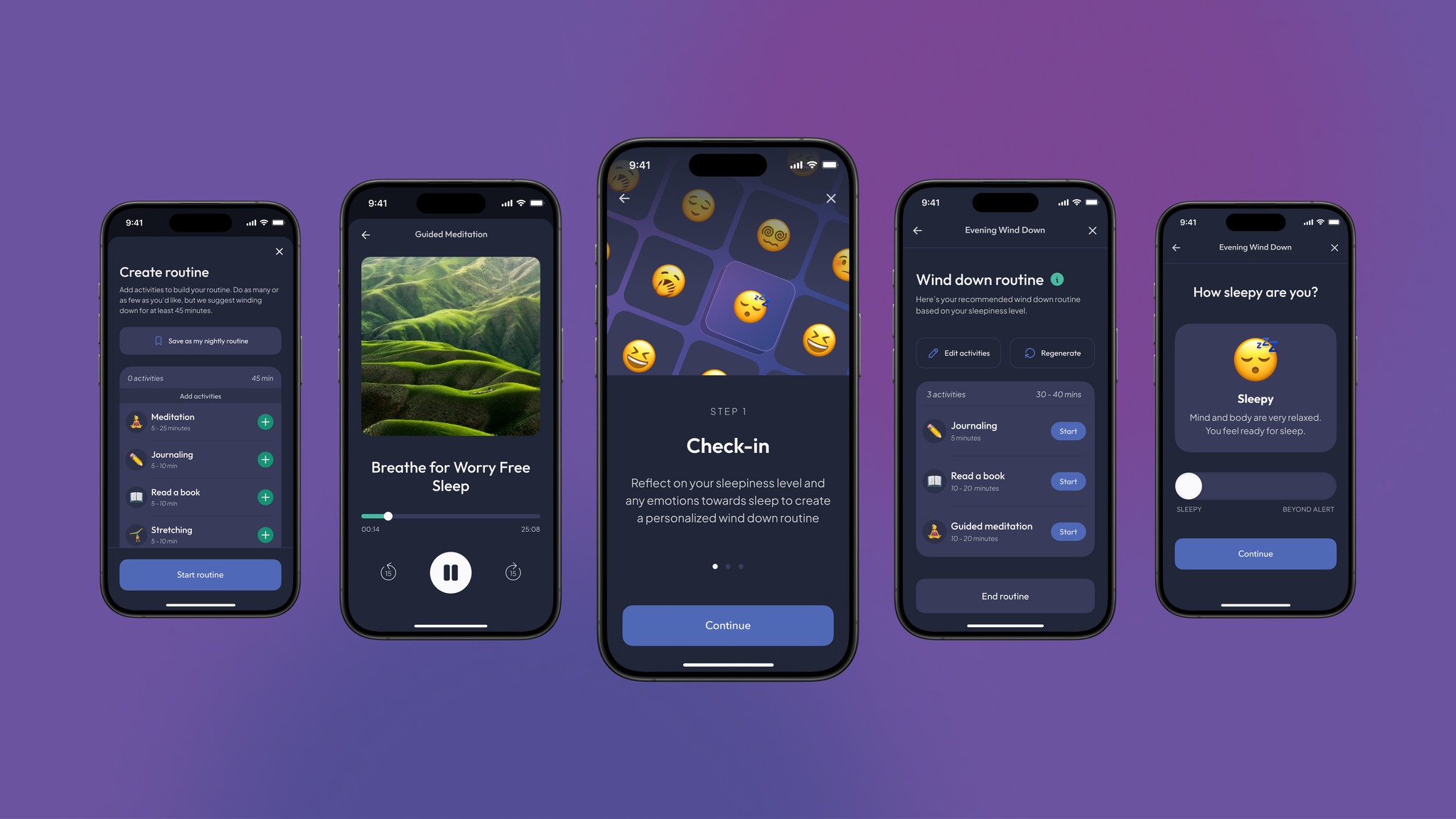
PROJECT BACKGROUND
Boosting app engagement to drive subscriber rates
Sleep Reset is a sleep improvement app that provides users with a curriculum of lessons, a daily sleep log to track sleep progress and relevant habits, and a customized sleep schedule to help them fall asleep faster and reduce nightly awakenings.
My team focused on increasing trial-to-subscriber conversion rates to help drive the business toward profitability, ensuring positive contribution margins.
The most reliable indicator of whether a user subscribes after their 7-day trial is their engagement with the app’s core features. For instance, users who completed three or more daily sleep logs during the trial converted to subscribers at a significantly higher rate.
A sleep app without helpful bedtime support features
Quantitative data showed that most users completed their daily lessons and sleep logs in the morning and wouldn't use the app again until the next morning. Users rarely engaged with evening features like the meditation library and journaling prompts.
User interviews revealed that, despite these features, they felt unsupported at night when struggling to fall asleep or experiencing sleep issues such as sleep anxiety and racing thoughts.
It became clear that adding an evening support feature would meet a key user need while also creating an opportunity to boost daily app engagement.
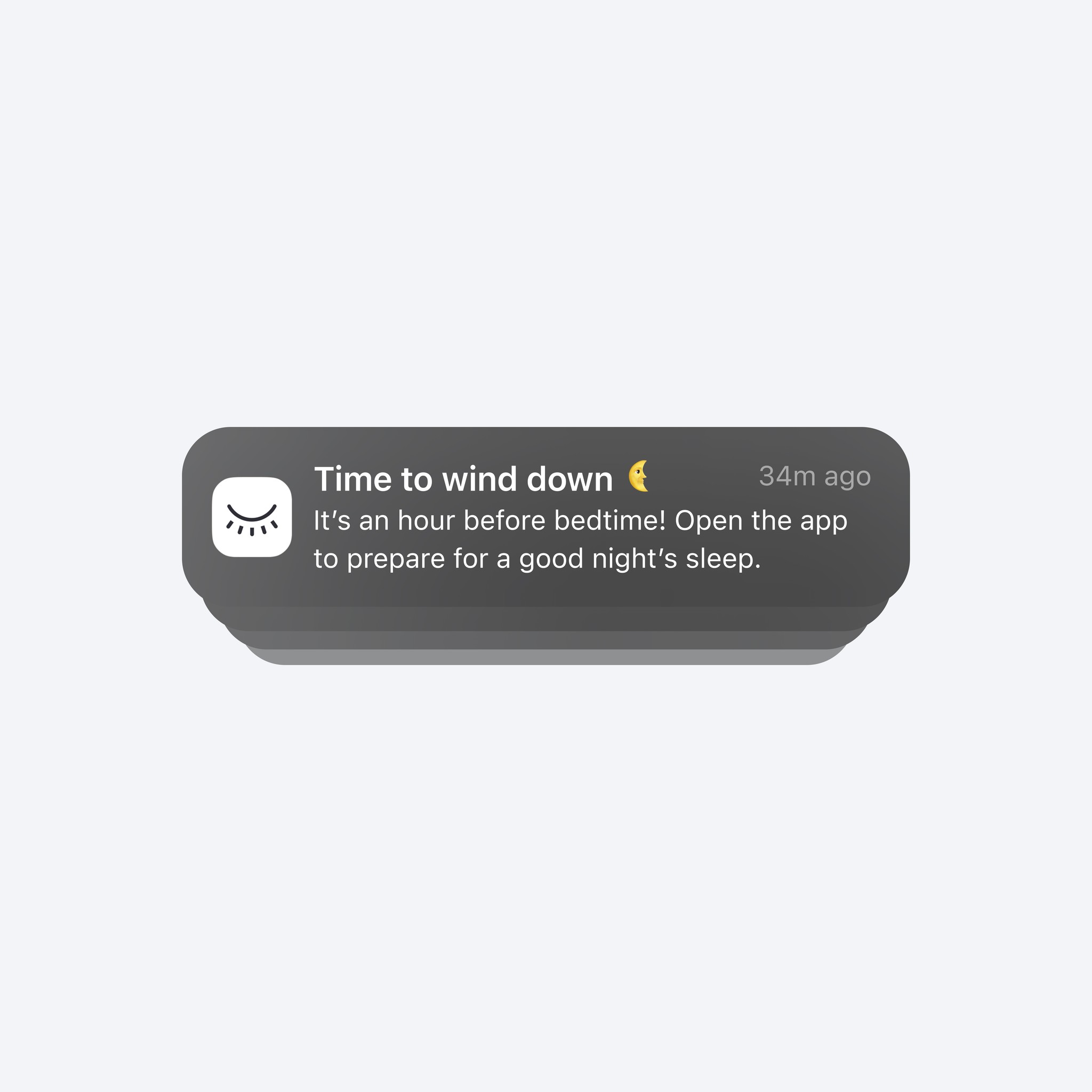
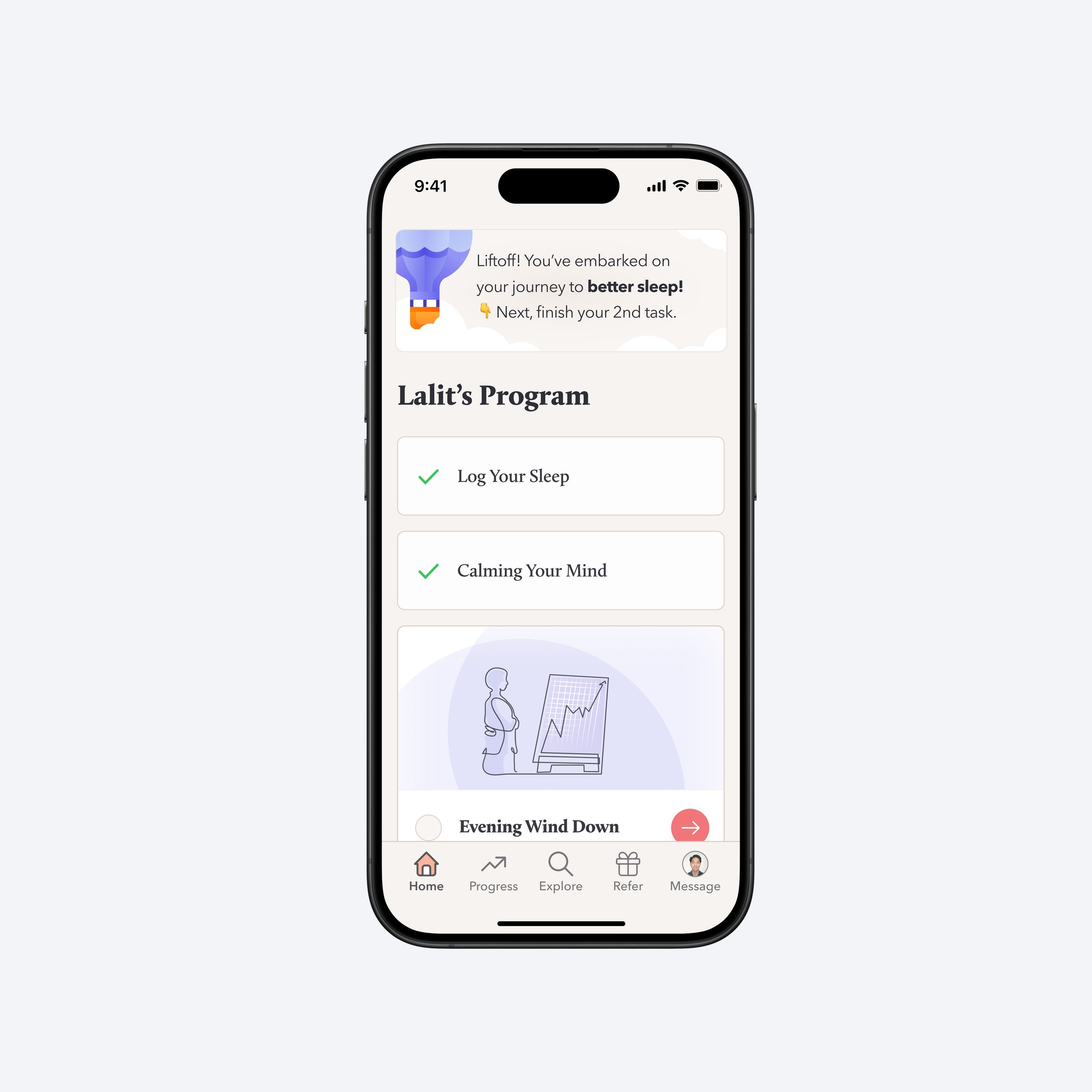
IDEATION
Conceptualizing the ideal evening experience
My product manager and I co-led a brainstorming session with engineers, sleep coaches, and stakeholders. We used "How Might We" brainstorm questions to generate ideas for features that would help users prepare for sleep with personalized and effective techniques that also served as a repeatable experience.
I began exploring the most promising ideas from the brainstorm in low-fidelity designs to identify pros and cons about their viability and feasibility. These ideas included:
Sleep Mode
A bedtime feature that locks the app into a "sleep" mode with a built-in morning alarm while surfacing meditations and sleep sounds to aid their sleep.
Journaling
Every night, ask users to log their activities and how they're feeling and provide relevant journaling prompts to put them in a more relaxed mindset for sleep.
Wind Down Routine
An evening feature to guide users through various sleep hygiene activities around their bedtime to promote better sleep quality.
Bedtime Affirmations
A community-based experience to let users share insights and tips on what has worked for them to improve their sleep.
Deciding to build a repeatable wind down routine feature
After exploring different concepts and discussing each solution's viability and feasibility with my product manager, we ruled out the following concepts:
Sleep Mode: It would be hard to get users to switch from their current alarm apps like Sleep Cycle or their native iOS alarm.
Journaling: A large percentage of users are generally not interested in journaling, leading to a risk of low engagement.
Bedtime Affirmations: Building and moderating a community-driven experience that depends on user participation had lower confidence on execution.
Our daily sleep lessons often encourage users to establish a consistent nightly wind-down routine, but offer no tools or guidance to help them implement it.
With over 50% of our sleep-deprived users not following a wind-down routine, we saw an opportunity to create a guided experience that aligned with our curriculum, met user needs, and could increase daily engagement.


WIND DOWN DEEP-DIVE
Using sleep science to create an effective wind down experience
I consulted with our team of sleep experts to understand what makes a wind-down routine effective, compile a comprehensive list of wind-down activities, and learn how they structure and personalize routines for their clients.
Wind down routines consist of various bedtime activities to calm the mind and relax the body before bedtime. Here are some key takeaways for an effective wind down:
Consistent Practice
Wind-down routines should be practiced consistently every night to signal to the brain that it's time for sleep, reduce stress, and foster positive sleep associations.
Wind Down Length
Wind down routines should last at least 30-60 minutes to allow enough time for the mind and body to transition to a state of relaxation that is conducive to sleep.
Range of Activities
A wind-down routine should include 2 to 5 activities, such as stretching, reading, meditation, or journaling. These should be personalized to their emotional state and personal preferences.
Reflection Required
It's important that users reflect on their emotional and sleepiness states in order to curate effective wind down routines.
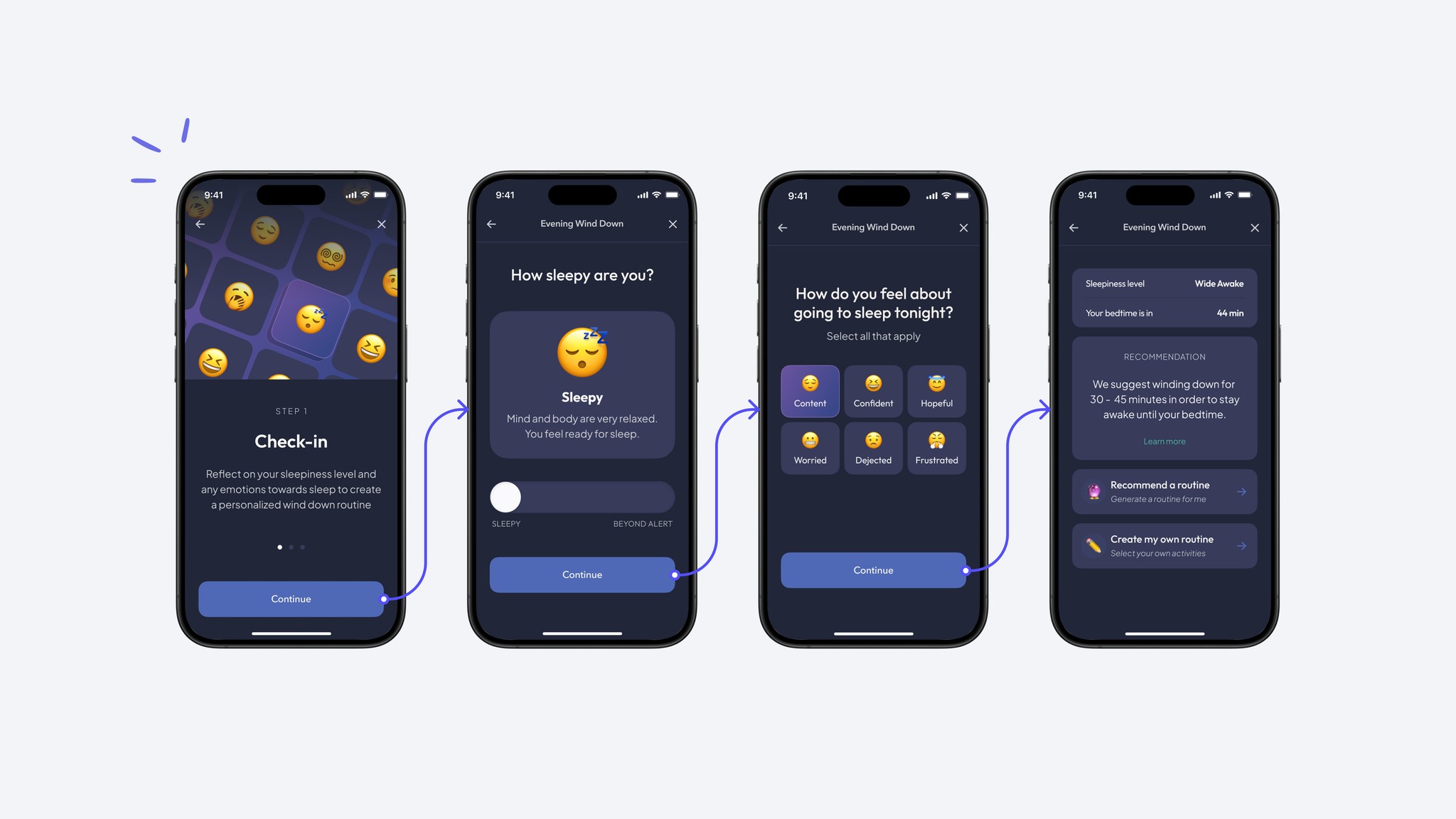
DESIGN
Crafting an experience that's easy to adopt and drives repeat engagement
As I started designing a new wind down feature, I defined several key factors to consider in the design that would increase our ability to build something effective that users would want to continue using on a nightly basis:
Personalized
Users need guidance on what activities to do and how long to do them for. Personalized suggestions can boost adoption and efficacy.
Customizable
Users can have strong preferences on what activities they enjoy or find effective. Sometimes it's based on what they're able to do.
Effortless
Users shouldn't have to spend time building a routine. In a sleep program, users prefer being prescribed the solution.
Repeatable
Many users like to practice the same routine every night. Being able to save or repeat a routine can drive repeat engagement.
Efficacy
Showing users the efficacy of consistently practicing a wind down routine can motivate users to stick to a new habit.
Gamification
Introducing gamification practices like completion streaks could drive repeat engagement.
Creating personalization logic
The two metrics we needed to collect in order to personalize wind down activities is a user's level of sleepiness and specific emotions associated with going to sleep (eg. anxiety).
Sleepiness Scale: Our curriculum teaches users to assess their sleepiness on a 5-point scale, ranging from Level 1 (Sleepy) to Level 5 (Beyond Alert). We decided to use this scale to determine the recommended duration for a wind-down routine, which can range from 30 minutes to 2 hours based on their self-assessment.
Emotional Intake: Curating effective wind-down activities relies on understanding the user's emotions related to sleep. For example, if a user feels anxious about sleep, a journaling prompt to reframe negative thoughts may be more helpful than meditation. We mapped each wind-down activity to associated emotions to create an effective recommendation logic.
By putting these two factors together, we were able to personalize the duration of a wind down routine and suggest activities that would be most beneficial to them reaching a state of sleepiness.
Feature discovery and adoption
We wanted to ensure this new feature was easily discoverable to drive engagement. These were key considerations made:
Feature Entry Point: Most users weren't utilizing the meditation library and journaling prompts in the Explore tab. Since we knew users spent the majority of their time on the home tab for their daily sleep log and lessons, we integrated the wind-down feature directly beneath their lessons. By framing it as part of their nightly curriculum, we encouraged users to return to it each evening.
Push Notifications: Since users weren’t in the habit of using the app in the evening, we needed to send timely reminders. Just as users received morning notifications to log their sleep and complete lessons, we introduced an evening push notification, sent two hours before bedtime, to prompt users to begin their wind-down routine.
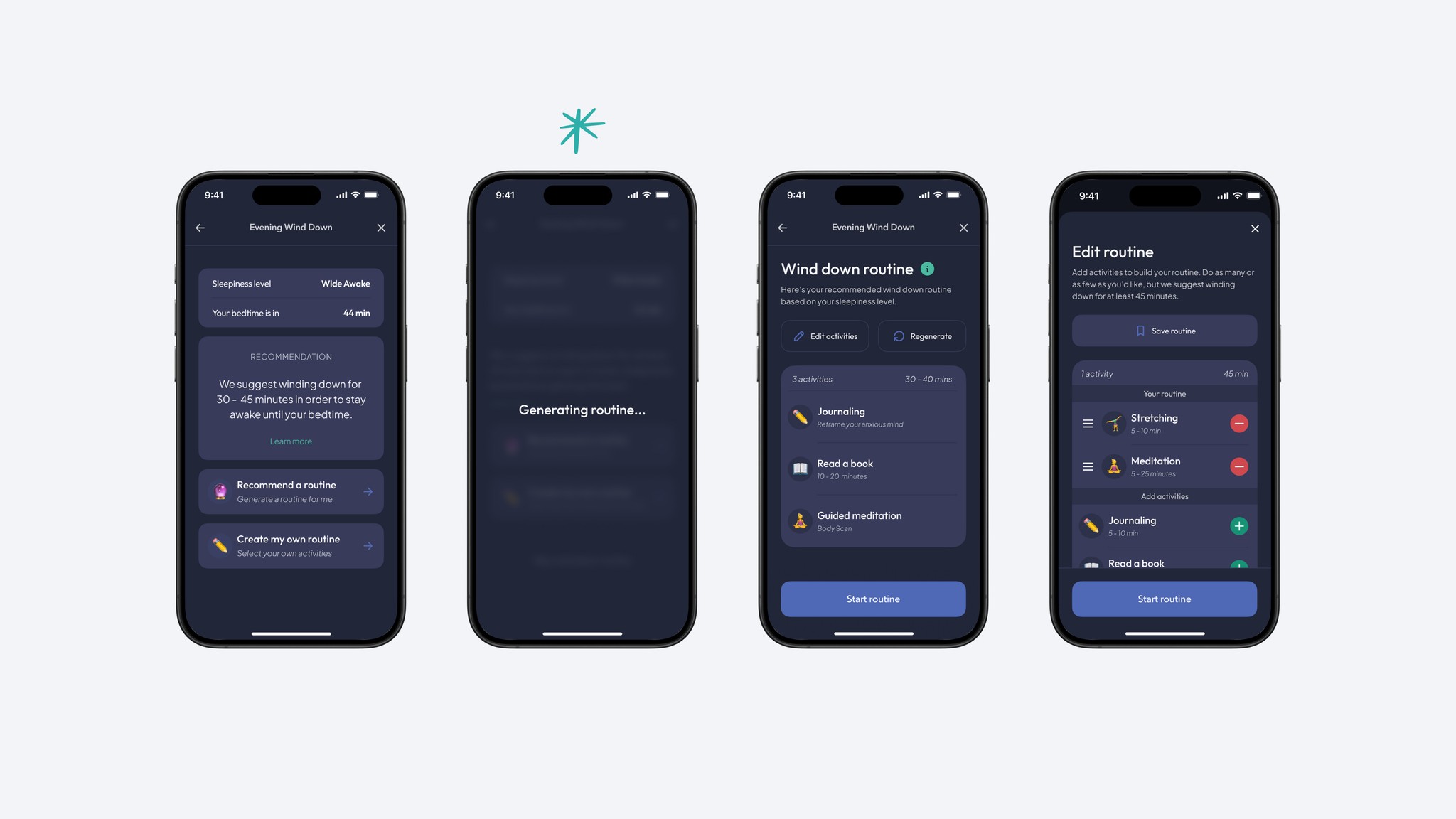
SCOPING
Reducing scope to build and test a new feature faster
I explored several designs that ranged in complexity from auto-generating routines to surfacing a generic list of activities.
In scoping discussions with my product and engineering leads, we made some key decisions to reduce time to build while ensuring we met minimum user needs. Here are the main takeaways:
Recommendations: We felt that it was important to follow the best practices of our program curriculum and provide a recommendation to users on how long they should wind down for. That meant keeping the sleepiness scale in order to recommend a wind down duration.
Routines: A routine is a set of activities in chronological order. We quickly ruled out auto-generating routines and saving routines due to its high implementation cost. However, without these features, it would put the effort on the user to build their own routines, which created an adoption risk. So without effortless routine building, we decided to scrap routines altogether and instead surface a generic list of activities that a user could pick from.
Activity Suggestions: Although we decided to go with a generic list of activities, we felt that our users needed some level of guidance to get them started and build adoption. By highlighting a few suggested activities at the top of the activity index, we could reduce decision fatigue. To reduce scope of this, we decided not to include any activity-to-emotion mapping and simply rotate between 6 different activities.






AFTERMATH
Wind down routines increased subscription rates by 21%
We initially launched this feature to 50% of trialers as an A/B test. We tracked engagement metrics, including first-time open rates, completion rates, and repeat usage. Our main goal was to understand how engagement with this feature impacted overall subscription conversion compared to the control group.
After two months, we saw that trialers that used the wind down feature at least 2 or more times were 21% more likely to subscribe than users who didn't use the feature.
After this finding, we proceeded to roll this initial iteration to all users.
Follow Up & Reflection
I think future iterations of this feature would first focus on increasing its discoverability so that we can increase subscription rates from users that aren't currently engaging with the feature.
I really enjoyed working on this project as it was serving an important business need but also had strong applications to improving a user's sleep by productizing a sleep hygiene practice.